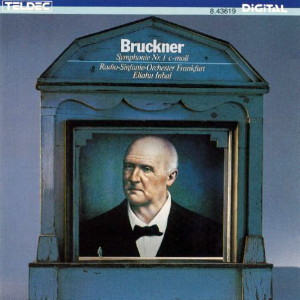 |
|
1 LP -
6.43619 AZ - (p) 1987
|
 |
| 1 CD -
8.43619 ZK - (p) 1987 |
|
| ANTON BRUCKNER
(1824-1896) |
|
|
|
|
|
| Symphonie
Nr. 1 c-moll - Linzer Fassung
von 1866 |
48' 05" |
|
-
Allegro
|
13' 10" |
|
| -
Adagio |
12' 24" |
|
| -
Scherzo: Schnell · Trio: Langsamer |
8' 21" |
|
| -
Finale: Bewegt, feurig |
14'
10" |
|
|
|
|
| Radio-Sinfonie-Orchester
Frankfurt |
|
| Elihau Inbal,
Leitung |
|
|
|
|
|
Luogo
e data di registrazione |
|
Alte
Oper, Frankfurt (Germania) - 29-30
gennaio 1987 |
|
|
Registrazione:
live / studio |
|
live |
|
|
Producer /
Engineer |
|
Heinz
Henke - Heinrich J. Weritz / Hans
Bernhard Bätzing - Michael Bramann
- Detlef Kittler (HR) |
|
|
Prima Edizione LP |
|
Teldec
- 6.43619 AZ - (1 LP) - durata 48'
05" - (p) 1987 - Digitale |
|
|
Prima Edizione CD |
|
Teldec
- 8.43619 ZK - (1 CD) - durata 48'
05" - (p) 1987 - DDD |
|
|
Note |
|
Co-Produktion
mit dem HR, Franfurt.
|
|
|
|
|
The history of
music is full of grotesque
figures. One only has to
think of Alkan, Liszt’s
great contemporary, who
chose to live in eccentric
seclusion; one only has to
think of Gesualdo, who
according to bourgeois
conceptions was not only a
composer but also at the
same time a perfectly
conventional murderer of two
people; one only has to
think of Liszt, who in the
course of his phases of
religious mania managed to
work his way up to the
position of Abbé -
the list could be continued
ad libitum. However, none
stood apart in his time so
remarkably, none moved into
the limelight so late in
life, at the same time
resenting such an
irresolvable contradiction
to his epoch, no
intellectual personality was
so shadowy, so unbelievably
helpless as Anton Bruckner.
His personality becomes all
the more enigmatic when one
takes into account that he
was deeply moved by the
derision, laughter and jokes
directed at him by his
environment, but that he
still could not in any way
be dissuaded from
systematically continuing
his creative work.
Bruckner was a naive
character, anything but a
man-of-the-world, but much
as one would like to, one
cannot claim that he had not
developed any intellectual
capabilities. For his
unbelievable gift for
construction and combination
in his symphonic works
cannot merely be explained
away as blessed instinct.
But in Bruckner’s case, as
opposed to that of his
colleagues, the element of
mental keenness expressed
itself without doubt and to
an unusual extent quite
differently: It found its
expression solely in
compositional work. This
fact makes it so difficult
to recognize where the
limits of inspiration and
dialectic work are to be
found. There has probably
never been a composer who
developed in such an
unbelievably persistent way,
at the same time so slowly.
The continuity with which
this process took place
significantly illuminates at
the same time that which is
possible in the mental
sphere: In the history of
music the hundreds of
composer child prodigies are
confronted by Bruckner as
the only adult prodigy, or
rather: almost an “old man
prodigy”.
Bruckner wrote 11 symphonies
altogether. He himself
described the first one in F
minor dating from 1862 as
“school work”, and another
one in D minor (“ Symphony
No. 0”) dates from 1863/64;
Bruckner re-worked it five
years later once more, but
declared towards the end of
his life that it was
“invalid”.
There are two versions of
the Symphony No. 1 in C
minor. He composed the first
version between May 1865 and
July 1866 in Linz; in 1866
he re-wrote the Adagio once
more. Bruckner performed
this work himself for the
first time on May 9th 1868
in the Redoutensaal in Linz.
The audience was bewildered.
Bruckner, who called the
work “Beserl”, which means
something like “street
urchin”, re-wrote it a
second time in 1890/ 91.
This was the origin of the
so-called Vienna version.
The changes did not affect
the overall structure as
much as details of the
instrumentation. The
composer dedicated the work
to the University of Vienna
in 1891 as a sign of his
gratitude for the award of
the title of honorary
Doctor. The first movement
is composed in sonata form;
the second is in ternary
song form with A flat major
as the basic key; the third
movement is a Scherzo in G
minor with a G major Trio,
while the Finale is again
composed in sonata form and
finds its way back to the
opening key of C minor. The
present recording is based
on the first version, the
so-called Linz original
version.
Translation:
Diana
Loos
|
|
|